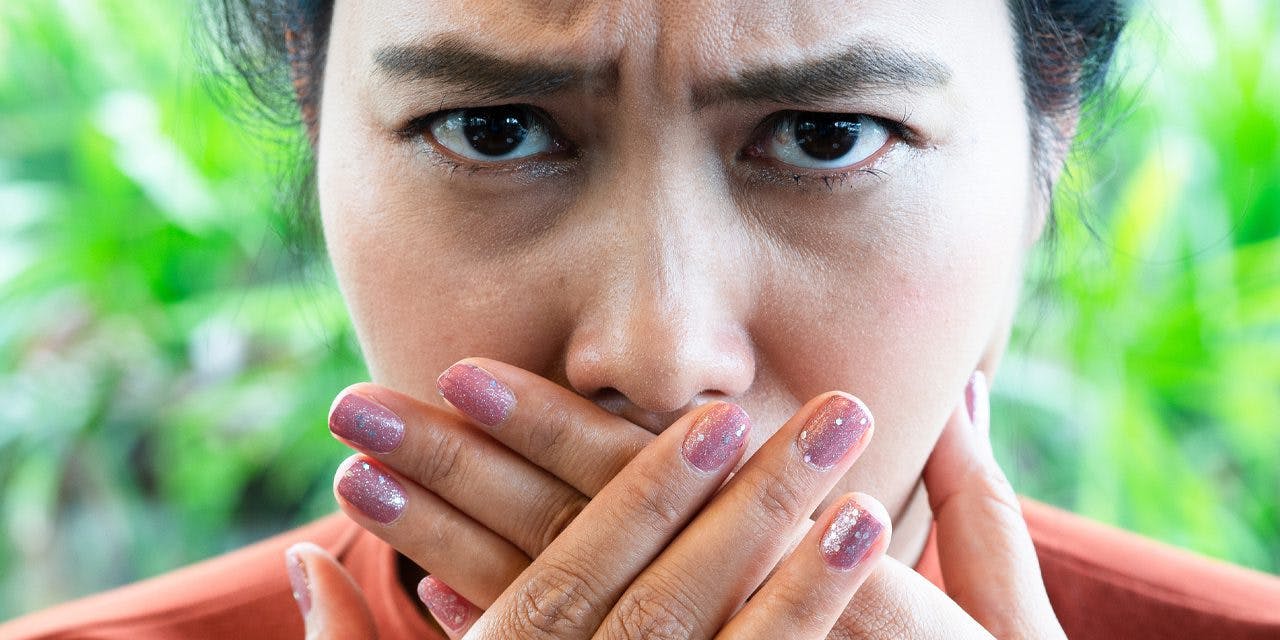Does Weed Cause Bad Breath?

Article written by
Emma Stone
Content reviewed by

Dr. Lewis JasseyMedical Director - Pediatric Medicine
You’re not alone if you’ve noticed your breath smells bad after smoking marijuana. Marijuana use can cause bad breath (halitosis), and this is due to THC in cannabis reducing saliva production and drying out the mouth.
Saliva plays a critical role in oral health by neutralizing harmful acids, killing germs, preventing periodontal disease (gum disease), keeping teeth healthy, and maintaining fresh breath. Halitosis arises when insufficient saliva is circulating in the mouth.
Let’s learn more about how THC impacts saliva production and how to avoid halitosis without cutting back on your cannabis intake.
Get your medical marijuana card
Connect with a licensed physician online in minutes.
The Link Between Marijuana and Bad Breath
Recreational users often observe that marijuana can lead to a dry mouth. While it’s sometimes called “cotton mouth” or “weed breath,” the medical term for an abnormally dry mouth is xerostomia.
THC, a major cannabinoid present in cannabis, can cause xerostomia. THC interacts with the body’s endocannabinoid system and can bind to cannabinoid receptors in the submandibular glands of the mouth. This binding action can reduce the quantity of saliva the glands produce.
The other major cannabinoid in the cannabis plant, CBD, may cause temporary xerostomia, too. According to a 2021 study that explored people’s motivations for using CBD, 44 of 388 people (11%) experienced a dry mouth due to using a CBD product.
Research suggests that cannabis users may have a higher risk of dental cavities, plaque, and less healthy gums since saliva plays an essential role in regulating oral health and inhibiting the growth of bacteria. When saliva flow dramatically decreases, bad breath is likely to follow.
Marijuana smoke can also exacerbate bad breath. Like cigarette smokers, pot smokers can experience “smoker’s breath,” which refers to the stale scent that lingers in the mouth after smoking. Research shows that smoking pot, in general, is linked to an increased risk of gum disease, such as gingivitis, another leading cause of bad breath.
While smoke may exacerbate bad breath, all forms of cannabis that contain THC can lead to halitosis. Marijuana edibles, tinctures, and gummies can all dry the mouth out due to the inhibitive effects of THC on the salivary glands. However, marijuana consumed orally takes longer to take effect as it has to be digested before circulating through the bloodstream to reach the salivary glands.
How to Avoid Halitosis Without Cutting Back on Weed
Xerostomia is believed to be dose-dependent, which means higher levels of cannabis consumption can lead to a higher likelihood of a dry mouth.
However, if you don’t want to cut back on weed, there are several tricks you can try that can help reduce cannabis-induced bad breath.
Sip Fluids
Sipping fluids while using weed can help keep your mouth moist. The operative word here is “sipping.” As the body isn’t dehydrated, there’s no need to gulp back enormous quantities of liquids, just enough to maintain wetness in the mouth. Water is best. Avoid caffeinated drinks such as tea, coffee, and energy beverages, as they can also reduce saliva production and contribute to bad breath.
Avoid Crossfading
Research shows that alcohol consumption can also inhibit the salivary glands and reduce the secretion of saliva in the mouth. Alcohol also acts as a diuretic and can reduce the total volume of fluid in the body, leading to dehydration and a dry mouth.
Some cannabis users combine alcohol and weed, a phenomenon known as “crossfading.” As both these substances can contribute to a dry mouth and bad breath, avoiding combining them is advisable to keep your breath smelling sweet.
Suck on Candy or Mints
Sucking hard candy and mints stimulates the salivary glands and keeps saliva flowing. Sugar-free chewing gum products can also be helpful: Many contain an active ingredient called xylitol, which increases saliva production.
Sucking and chewing generally work muscles in the mouth and facilitate saliva flow. As a bonus, mints help to keep the breath smelling fresh.
Swap Smoking for Edibles, Tinctures, or Capsules
As discussed earlier, marijuana smoking can lead to negative effects on oral health that can exacerbate bad breath. Edibles, tinctures, and capsules represent alternative delivery methods that won’t leave the residue of stale cannabis smoke lingering in your mouth.
Practice Good Oral Hygiene
Clean your teeth after using cannabis, mainly if you’re smoking weed. Keep your equipment (like pipes and bongs) clean to reduce the likelihood of bacteria building up and contributing to bad breath. Flossing and tongue scrapers can also help keep bad breath at bay.
The Bottom Line
There are two main reasons why weed can cause bad breath: THC can inhibit saliva production, and smoking marijuana can allow unpleasant odors to build up in the mouth.
Fortunately, there are several ways you can avoid halitosis without cutting back on weed. Promote fresh-smelling breath by sipping fluids while using cannabis, avoid using cannabis with alcohol, suck on mints or chew gum, and swap out smoking for other delivery methods.
Get Your Medical Card
Connect with a licensed physician online in minutes.
